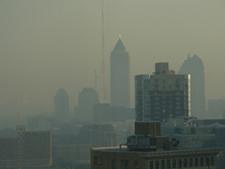Ozone
A single atom can make a big difference in the way a molecule works — so can its location. The everyday air we breathe has two atoms of oxygen (O2) in it. Ozone is a gas made up of three atoms of oxygen (O3). And while we need oxygen to survive, ozone can either help us or hurt us — depending on where it is.
What’s the difference between helpful and harmful ozone?
Ozone can be helpful or harmful to your health and the environment, depending on its location in the atmosphere. Helpful ozone exists naturally high above the Earth’s surface and protects us from the sun’s ultraviolet rays (radiation). Human-made air pollutants damage the helpful ozone.
Harmful ozone is close to the ground. It comes from human activities that release chemicals into the air, which react with sunlight to create ground-level ozone.
How can ozone affect my health?
When human-made air pollutants destroy helpful ozone, people may receive too much ultraviolet radiation. This may cause:
- Cataracts (clouding of eye lens, which leads to poor vision)
- Problem with immune system (the system that fights diseases)
- Skin cancer
Too much ultraviolet radiation may also damage crops (plants we grow for food) and other plants.
Contact with harmful ozone can cause:
- Coughing
- Irritated throat
- Worsening in respiratory (breathing) disorders, such as asthma and bronchitis
Regular contact with ozone can also cause permanent damage to the lungs, especially in children, because their lungs are still developing.
Some content courtesy of the National Library of Medicine.



